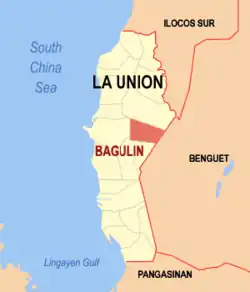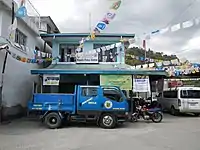Bagulin | |
|---|---|
| Municipality of Bagulin | |
 Bagulin town center | |
 Flag  Seal | |
 Map of La Union with Bagulin highlighted | |
OpenStreetMap | |
.svg.png.webp) Bagulin Location within the Philippines | |
| Coordinates: 16°36′28″N 120°26′16″E / 16.607903°N 120.437833°E | |
| Country | Philippines |
| Region | Ilocos Region |
| Province | La Union |
| District | 2nd district |
| Founded | 1963 |
| Barangays | 10 (see Barangays) |
| Government | |
| • Type | Sangguniang Bayan |
| • Mayor | Virgilio C. Flor |
| • Vice Mayor | Jaime A. Lictao |
| • Representative | Sandra Y. Eriguel |
| • Municipal Council | Members |
| • Electorate | 9,608 voters (2022) |
| Area | |
| • Total | 107.33 km2 (41.44 sq mi) |
| Elevation | 282 m (925 ft) |
| Highest elevation | 885 m (2,904 ft) |
| Lowest elevation | 28 m (92 ft) |
| Population (2020 census)[3] | |
| • Total | 14,428 |
| • Density | 130/km2 (350/sq mi) |
| • Households | 3,341 |
| Economy | |
| • Income class | 5th municipal income class |
| • Poverty incidence | 5.5 |
| • Revenue | ₱ 99.82 million (2020) |
| • Assets | ₱ 209.3 million (2020) |
| • Expenditure | ₱ 80.85 million (2020) |
| • Liabilities | ₱ 19.12 million (2020) |
| Service provider | |
| • Electricity | La Union Electric Cooperative (LUELCO) |
| Time zone | UTC+8 (PST) |
| ZIP code | 2512 |
| PSGC | |
| IDD : area code | +63 (0)72 |
| Native languages | Ilocano Tagalog |
| Website | www |
Bagulin, officially the Municipality of Bagulin (Ilocano: Ili ti Bagulin; Filipino: Bayan ng Bagulin), is a 5th class municipality in the province of La Union, Philippines. According to the 2020 census, it has a population of 14,428 people.[3]
Etymology
Tradition reveals that Bagulin derived its name from a Kankanaey tribal leader. In the middle of the 18th century, the municipality was part of the township of Allabok which covered the moderate slopes of the mountain ranges overlooking the South China Sea. During those times, Allabok involved itself in a tribal war headed by Bagulin who led the community to victory. From then on until his death, people highly regarded him as their noble leader. After his death, consensus with the residents together with the concurrence of Spanish authorities resulted in naming the community after Bagulin.
Another etymological version dictates that "Bagulin" was derived from the term bago which means "lowland natives". This version is further supported by the fact that Kankanaeys comprise about 85% of the population.
History
The community was moved to Picdel, a narrow valley strip along the Naguilian-Bagulin river. By 1903, the American regime established a military government and institutional facilities. Education was introduced and a bamboo community hall roofed with cogon was erected. In 1903, the community was placed under the jurisdiction of the Mountain Province, sub-province of Benguet. By 1918, under the agreement of Governor Guzman of Mt. Province and Governor Pio Ancheta of La Union, Bagulin became a municipal district of Burgos under the province of La Union.
By 1928, the community centers were moved to a nearby settlement called Suyo where the present town center is situated. The former community center was named “Nangalisan” which means an abandoned place in the Ilokano language. Settlers who improved Suyo were Ilokano people who came from Naguilian. At that time, a bamboo chalet was constructed to serve as an administrative hall. The administration then was composed of the Mayor, a Secretary-Treasurer, and one policeman.
On June 25, 1963, Bagulin was transformed into a regular, full-pledged municipality by virtue of Executive Order No. 42.
Geography
Bagulin is situated at the interior eastern portion of La Union. It is generally mountainous and forested. It is bounded by the following municipalities:
- North — San Gabriel
- West — City of San Fernando
- Southwest — Naguilian
- South — Burgos
- East — Kapangan
Bagulin is 31 kilometres (19 mi) away from San Fernando, the regional center, 14 kilometres (8.7 mi) away from Naguilian, its nearby town and 62 kilometres (39 mi) away from Baguio City. The main entrance to lowland municipalities is through the Naguilian-Bagulin Road. It can be reached by vehicles and any regular means of transportation through the town of Naguilian.
Barangays
Bagulin is politically subdivided into 10 barangays. [5] Each barangay consists of puroks and some have sitios.
- Alibangsay
- Baay
- Cambaly
- Cardiz
- Dagup
- Libbo
- Suyo (Poblacion)
- Tagudtud
- Tio-angan
- Wallayan
Climate
| Climate data for Bagulin, La Union | |||||||||||||
|---|---|---|---|---|---|---|---|---|---|---|---|---|---|
| Month | Jan | Feb | Mar | Apr | May | Jun | Jul | Aug | Sep | Oct | Nov | Dec | Year |
| Mean daily maximum °C (°F) | 30 (86) |
31 (88) |
32 (90) |
33 (91) |
32 (90) |
31 (88) |
30 (86) |
29 (84) |
30 (86) |
31 (88) |
31 (88) |
30 (86) |
31 (88) |
| Mean daily minimum °C (°F) | 21 (70) |
22 (72) |
23 (73) |
25 (77) |
26 (79) |
25 (77) |
25 (77) |
25 (77) |
25 (77) |
24 (75) |
23 (73) |
21 (70) |
24 (75) |
| Average precipitation mm (inches) | 42 (1.7) |
48 (1.9) |
74 (2.9) |
110 (4.3) |
269 (10.6) |
275 (10.8) |
362 (14.3) |
325 (12.8) |
330 (13.0) |
306 (12.0) |
126 (5.0) |
61 (2.4) |
2,328 (91.7) |
| Average rainy days | 11.2 | 12.0 | 17.1 | 21.2 | 27.1 | 26.8 | 28.1 | 27.0 | 26.0 | 24.5 | 17.7 | 12.4 | 251.1 |
| Source: Meteoblue[6] | |||||||||||||
Demographics
| Year | Pop. | ±% p.a. |
|---|---|---|
| 1918 | 2,419 | — |
| 1939 | 3,584 | +1.89% |
| 1948 | 3,101 | −1.60% |
| 1960 | 4,407 | +2.97% |
| 1970 | 5,338 | +1.93% |
| 1975 | 6,423 | +3.78% |
| 1980 | 7,009 | +1.76% |
| 1990 | 9,418 | +3.00% |
| 1995 | 10,780 | +2.56% |
| 2000 | 11,857 | +2.06% |
| 2007 | 12,521 | +0.75% |
| 2010 | 12,590 | +0.20% |
| 2015 | 13,456 | +1.27% |
| 2020 | 14,428 | +1.38% |
| Source: Philippine Statistics Authority[7][8][9][10] | ||
In the 2020 census, the population of Bagulin was 14,428 people,[3] with a density of 130 inhabitants per square kilometre or 340 inhabitants per square mile.
Economy
Government
Local government
Bagulin, belonging to the second congressional district of the province of La Union, is governed by a mayor designated as its local chief executive and by a municipal council as its legislative body in accordance with the Local Government Code. The mayor, vice mayor, and the councilors are elected directly by the people through an election which is being held every three years.
Elected officials
| Position | Name |
|---|---|
| Congressman | Sandra Y. Eriguel |
| Mayor | Virgilio C. Flor |
| Vice-Mayor | Jaime A. Lictao |
| Councilors | Ferdinand D. Tumbaga |
| Eduardo R. Compas | |
| Warton E. Sacpa | |
| Joel E. Nang-is | |
| Natalia R. Mazon | |
| Robeo B. Sallatic | |
| Prescila D. Dumaguing | |
| Juanito C. Badbadaoi | |
National Cultural Treasure
The town is home to one National Cultural Treasure of the Philippines, which is the Burial Caves of Sitio Alabok in Barangay Cambali.
Gallery
 Municipal hall
Municipal hall Police station
Police station Street view
Street view Landscape
Landscape Tiger grass, used for making soft brooms
Tiger grass, used for making soft brooms
References
- ↑ Municipality of Bagulin | (DILG)
- ↑ "2015 Census of Population, Report No. 3 – Population, Land Area, and Population Density" (PDF). Philippine Statistics Authority. Quezon City, Philippines. August 2016. ISSN 0117-1453. Archived (PDF) from the original on May 25, 2021. Retrieved July 16, 2021.
- 1 2 3 Census of Population (2020). "Region I (Ilocos Region)". Total Population by Province, City, Municipality and Barangay. Philippine Statistics Authority. Retrieved 8 July 2021.
- ↑ "PSA Releases the 2018 Municipal and City Level Poverty Estimates". Philippine Statistics Authority. 15 December 2021. Retrieved 22 January 2022.
- ↑ "Province: La Union". PSGC Interactive. Quezon City, Philippines: Philippine Statistics Authority. Retrieved 12 November 2016.
- ↑ "Bagulin: Average Temperatures and Rainfall". Meteoblue. Retrieved 26 April 2020.
- ↑ Census of Population (2015). "Region I (Ilocos Region)". Total Population by Province, City, Municipality and Barangay. Philippine Statistics Authority. Retrieved 20 June 2016.
- ↑ Census of Population and Housing (2010). "Region I (Ilocos Region)" (PDF). Total Population by Province, City, Municipality and Barangay. National Statistics Office. Retrieved 29 June 2016.
- ↑ Censuses of Population (1903–2007). "Region I (Ilocos Region)". Table 1. Population Enumerated in Various Censuses by Province/Highly Urbanized City: 1903 to 2007. National Statistics Office.
{{cite encyclopedia}}: CS1 maint: numeric names: authors list (link) - ↑ "Province of La Union". Municipality Population Data. Local Water Utilities Administration Research Division. Retrieved 17 December 2016.
- ↑ "Poverty incidence (PI):". Philippine Statistics Authority. Retrieved December 28, 2020.
- ↑ "Estimation of Local Poverty in the Philippines" (PDF). Philippine Statistics Authority. 29 November 2005.
- ↑ "2003 City and Municipal Level Poverty Estimates" (PDF). Philippine Statistics Authority. 23 March 2009.
- ↑ "City and Municipal Level Poverty Estimates; 2006 and 2009" (PDF). Philippine Statistics Authority. 3 August 2012.
- ↑ "2012 Municipal and City Level Poverty Estimates" (PDF). Philippine Statistics Authority. 31 May 2016.
- ↑ "Municipal and City Level Small Area Poverty Estimates; 2009, 2012 and 2015". Philippine Statistics Authority. 10 July 2019.
- ↑ "PSA Releases the 2018 Municipal and City Level Poverty Estimates". Philippine Statistics Authority. 15 December 2021. Retrieved 22 January 2022.
- ↑ "2019 National and Local Elections" (PDF). Commission on Elections. Retrieved March 6, 2022.